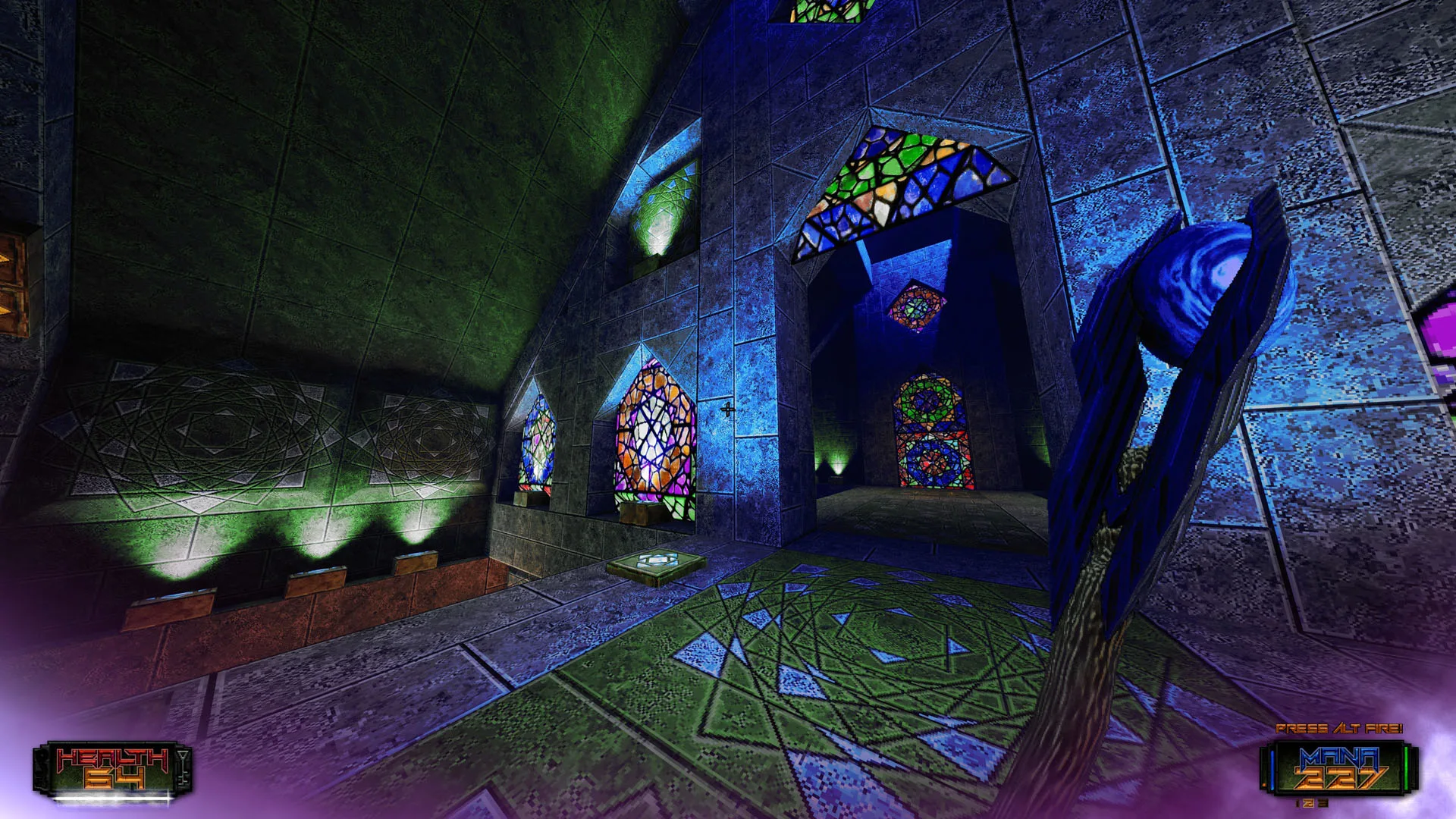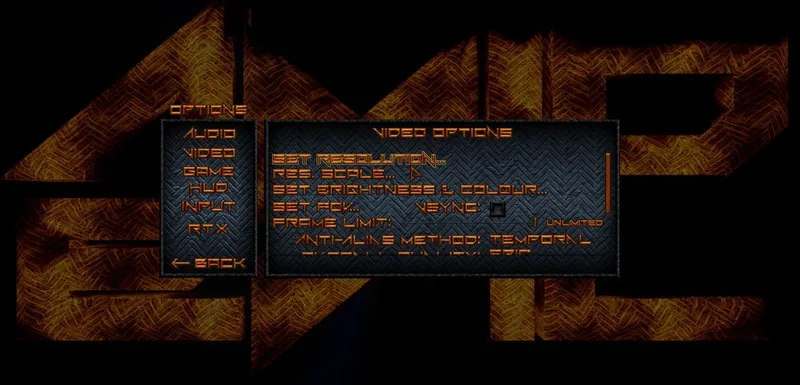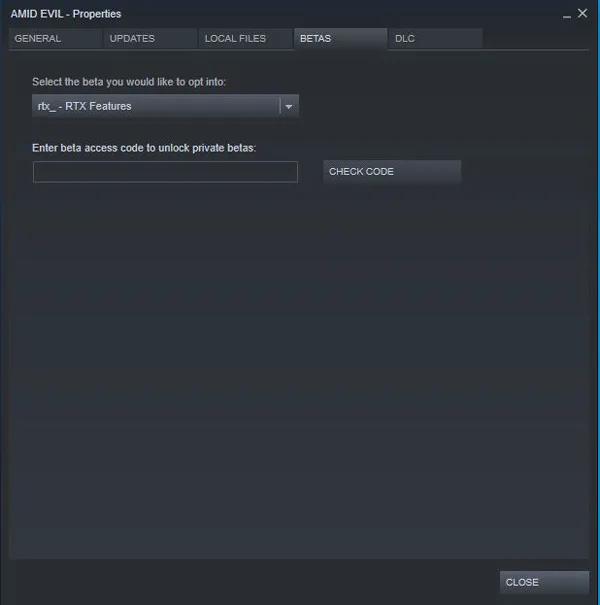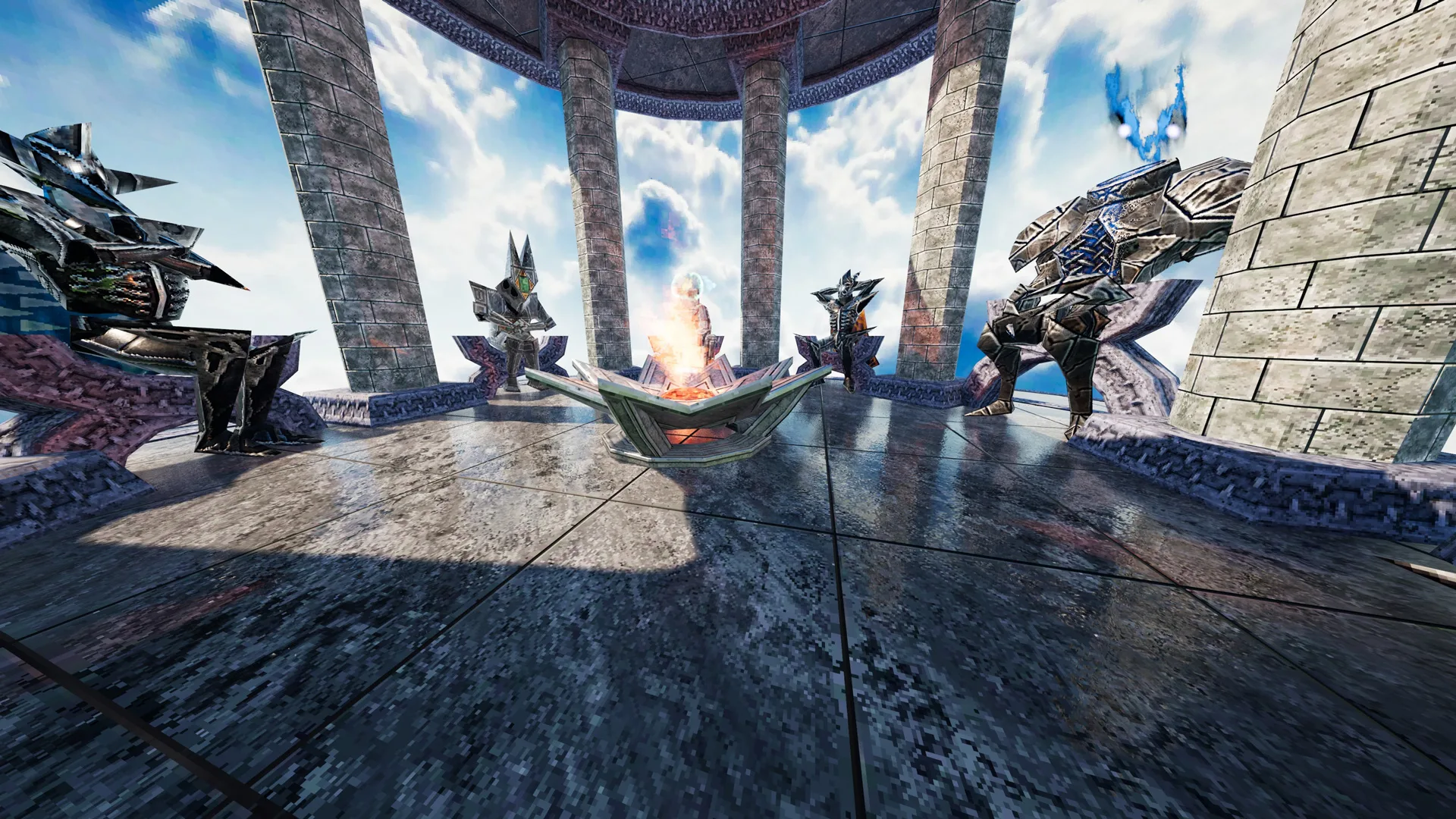Indie Ray Traced Games, Part 3 – the ‘AMID EVIL’ RTX Performance/Image Quality Review
NVIDIA introduced realtime RTX ray tracing nearly two years ago, and currently there are seven modern AAA games that support it. However, BTR’s indie ray tracing series covers the image quality (IQ) and performance of the four small studio games that have implemented RTX so far. AMID EVIL is an indie game that pays homage to the 1990s first person shooters but with amazing retro visuals using Unreal Engine 4.
Amid Evil is a retro first-person shooter developed by Indefatigable and published by New Blood Interactive. It bucks the modern trend of multiplayer games by concentrating on the single player campaign, and it delivers at least 10 to 30 or more hours of fun for about half the launch price of Quake II in 1997. BabelTechReviews purchased a copy of AMID EVIL from Steam for $19.99, and we began playing it using a RTX 2060 Super just because we wanted to check out the RTX implementation.
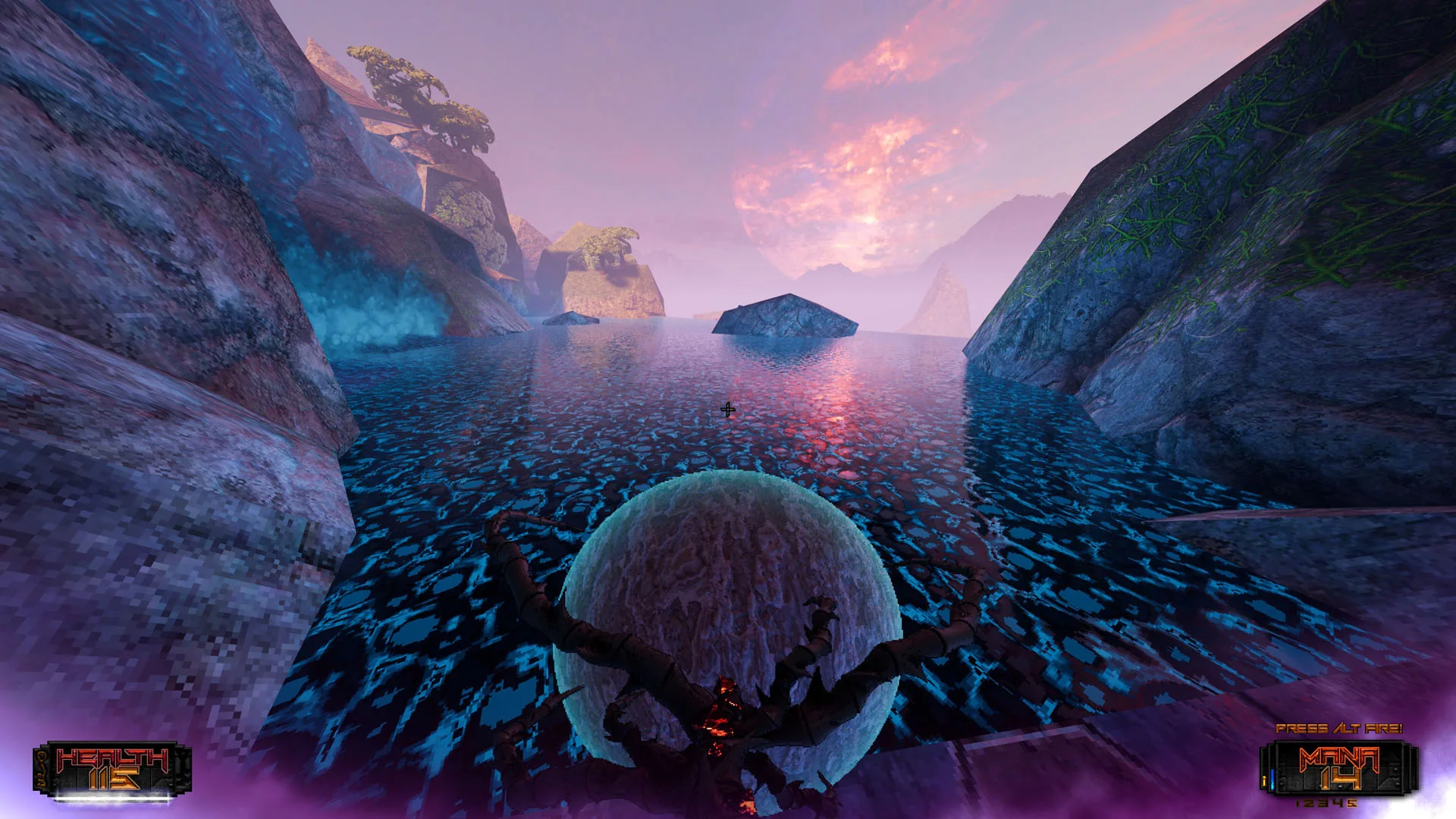
Although we didn’t anticipate playing it all the way through, we were immediately hooked by its intense gameplay and exciting fast-paced first player shooter elements that successfully combine running-and-gunning with extraordinary magic weapons. By magic we mean capturing, miniaturizing, and shooting planets as projectiles, or creating multiple black holes, and using rare power ups that briefly allow the player to become invulnerable or invisible. Even the weakest ranged weapon, the Staff of the Azure Orb, can be useful all through the game because its blue mana-fueled shots home in on the enemies. But all of the weapons have counterparts in the traditional FPS arsenal.
The Star of Torment mace acts like a shotgun that shoots a cluster of green mana-fueled spikes, leaving NPCs impaled on walls. The Whisper’s Edge sword also uses green mana but fires off a force slash that counters some of the enemy NPC’s blue attacks to hit multiple targets. The Celestial Claw that shoots planets is a rocket launcher. The Voltride trident fires lightening that can chain like a rail gun. Even the Aeturnum ribbon-weapon is basically a screen-clearing BFG-9000 which shoot out purple balls of energy that create black holes to pull in Enemy NPCs. These ultra-serious weapons are necessary because the many varied enemy NPCs use great adaptive AI tactics to hunt you down, flank, and mob you. This isn’t the AI of the classic games.
We played all the way through AMID EVIL, taking around 30 hours because we love to explore and to try to find the many cleverly hidden secrets on our own without using a walkthrough nor any cheats that are listed in the game’s Codex menu. It reminded us of the original joy we had discovering early FPS classics in the 1990s.
AMID EVIL is a very smart game. It is a retro remastering and reimagining of what the early classics like Quake, Doom, Hexen, Heretic, and even what Painkiller and Serious Sam should have been like. The very best elements of the 1990s classics have been mashed together into a very original shooter with upgraded visuals, enhanced enemy NPC AI, and improved gameplay mechanics.
AMID EVIL is built on Unreal Engine 4 and its beta even supports RTX ray tracing, yet its look is retro. Weapons are all normal mapped sprites, and many textures are deliberately kept low, but the lighting, shadowing, and intense color palate are significant upgrades over any game from the 1990s. The sky boxes are awesome and they add to the incredible atmosphere.
 The game performance is excellent on DX11, and a RTX 2060 Super gets 60+FPS at 4K Epic/TAA settings although it drops off massively with DX12/RTX On. In fact, DX11 plays fluidly on our ancient, nearly decade-old, Dell M4600 Core i7 2820QM notebook with Quadro 1000M graphics at 1080P using mostly lower settings with TAA applied.
The game performance is excellent on DX11, and a RTX 2060 Super gets 60+FPS at 4K Epic/TAA settings although it drops off massively with DX12/RTX On. In fact, DX11 plays fluidly on our ancient, nearly decade-old, Dell M4600 Core i7 2820QM notebook with Quadro 1000M graphics at 1080P using mostly lower settings with TAA applied.
Our impression of AMID EVIL will include testing the performance of its real time RTX ray tracing implementation across NVIDIA’s current RTX card lineup. We will also compare DX11 versus DX12 performance, and then with ray tracing on versus off. The game also supports NVIDIA’s Ansel although we had issues using it because ALT+F2 also brings up an in-game menu. All of the screenshots were captured using Steam or Fraps.
The Gameplay
AMID EVIL backstory is a rather generic fantasy vehicle to tie together and move the all-important action forward. The game’s focus is mostly on the gameplay and the progression through its seven huge levels although there are lore messages written on the walls that give some backstory as well as a Codex.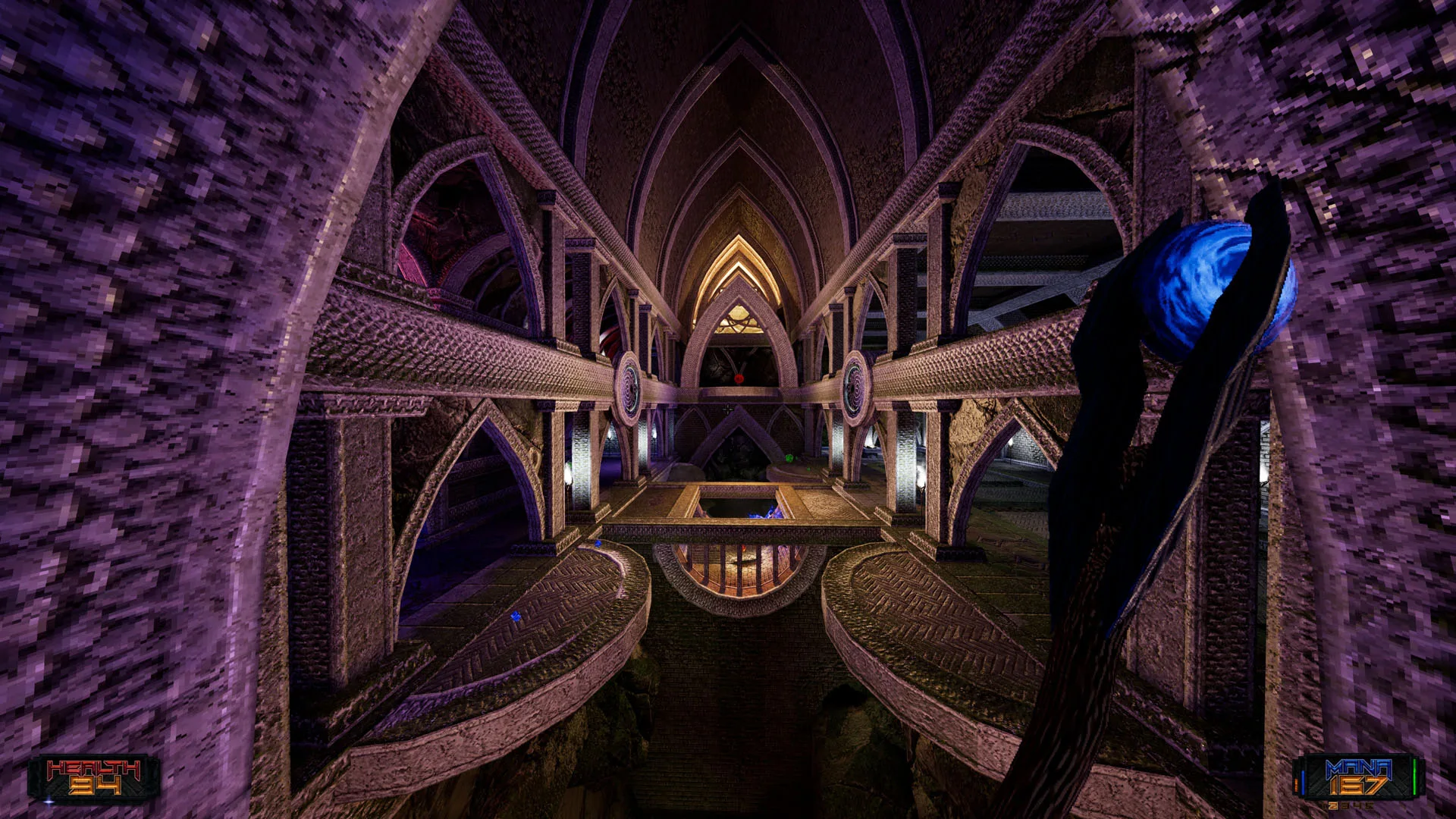
The story begins with you as the one chosen to rid the universe of great EVIL. You start with a powerful great Axe of the Black Labyrinth as your only mele weapon but with special properties that pull your enemies toward you. You progress through the game by equipping all six spell-based weapons you find and fuel with four different types of mana scattered all throughout the game. Although all of the weapons will cause damage to every enemy, some weapons cause a lot more damage than others, and you will need to use trial and error to find which weapons work best for each enemy.
Your health will not regenerate so you will need to find health pickups to survive. As with the Painkiller series, you absorb the souls of the dead NPCs to charge a meter which when full allows you to unleash a supercharged alternate fire attack for each weapon for a limited time. For example, the Celestial Claw will shoot suns instead of planets in the soul-charged alt-fire mode. This allows all of the weapons including even the relatively less powerful ones to be used consistently all through the game. Even the Axe becomes a soul supercharged spinning propeller blade to mow through enemy NPCs like grass.
Progression is allowed by hitting blue switches directly, or silver and gold switches that are activated only by finding and using the right key. Hitting a switch will generally open up a new path – and also trigger a mob of enemy NPCs. So there is a lot of exploring built into the game with many cleverly hidden secrets to discover and traps to avoid in the platforming sections.
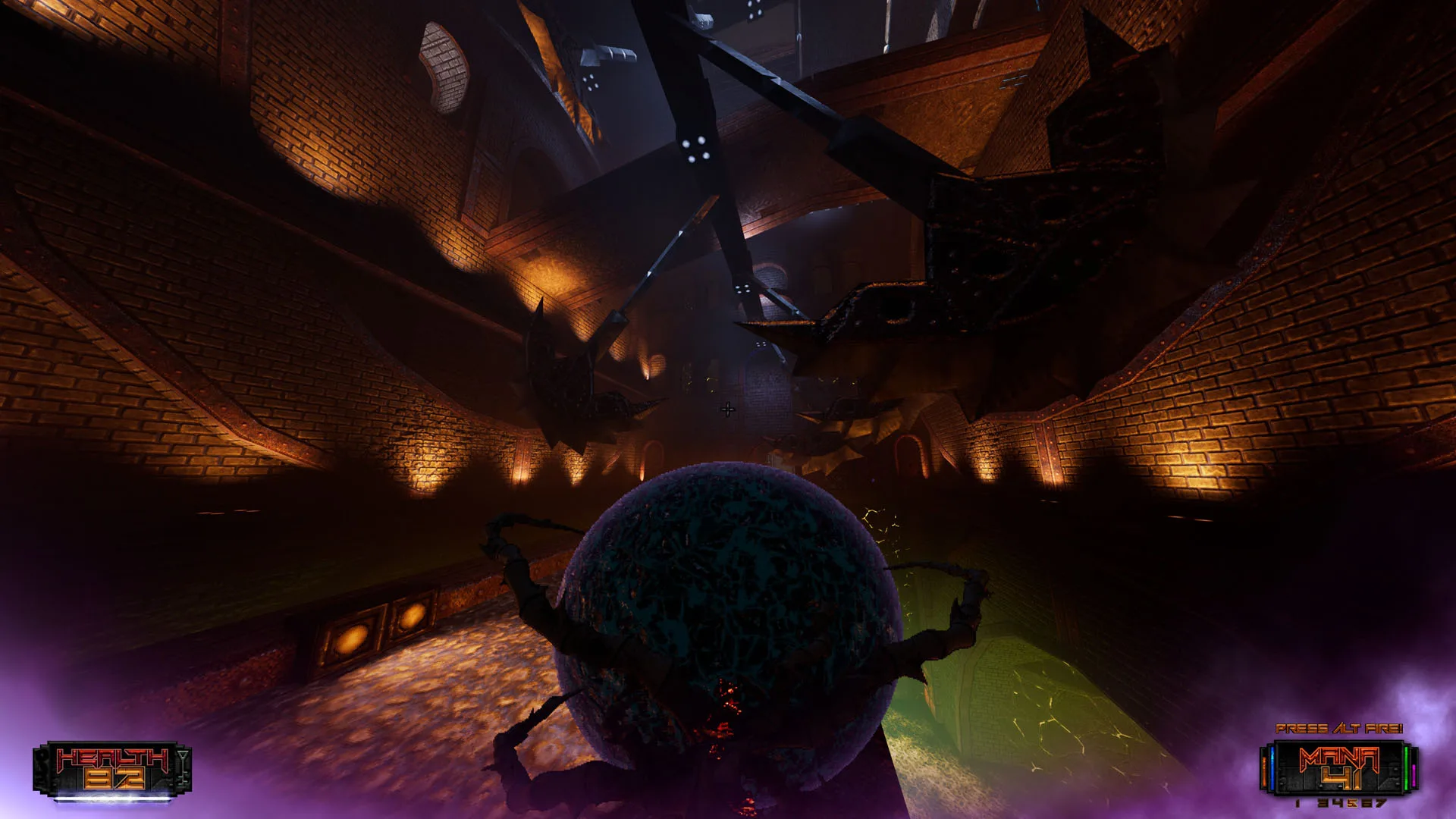
The indoor and outdoor maps are all artistically designed and beautifully rendered, and it reminds us of the classics and also of more modern level design like American McGee’s Alice/Madness Returns. Each of the seven levels are huge with narrow and cramped corridors opening into wide-open spaces, moving from underground dungeons to towering structures in the sky. Best of all, each level features a design very different from the others, and they also have their own unique enemy NPCs.
Although the game maps are huge, the player’s movement speed is very fast and always-run can be toggled on. So a lot of area can be covered in a very short time. Because of the nearly constant enemy attacks, strafing and run-and-gun shooting are the primary strategy. It becomes very frantic – simultaneously firing on a mob while avoiding incoming fire and at the same time picking up mana and health orbs. Fortunately there is a quicksave (F5) and quickload (F9) key – which is almost like cheating. However, quicksave is very useful for the sections with difficult jumps, and also for the times you find yourself with low health balancing on a narrow platform while fending off mass enemies.
The quicksave system becomes more necessary for the higher difficulties – EVIL Mode is hardcore/nightmare – but it sometimes becomes a quest for perfection to kill the maximum amount of enemies without getting hit; quick save and then continue and quickload again if you lose any health. Some of the battles can take awhile until you learn the NPC attack patterns – and different enemies are introduced with each level. However, quicksave is disabled for Horde mode (“No cheating, Scum” is the message if you try).
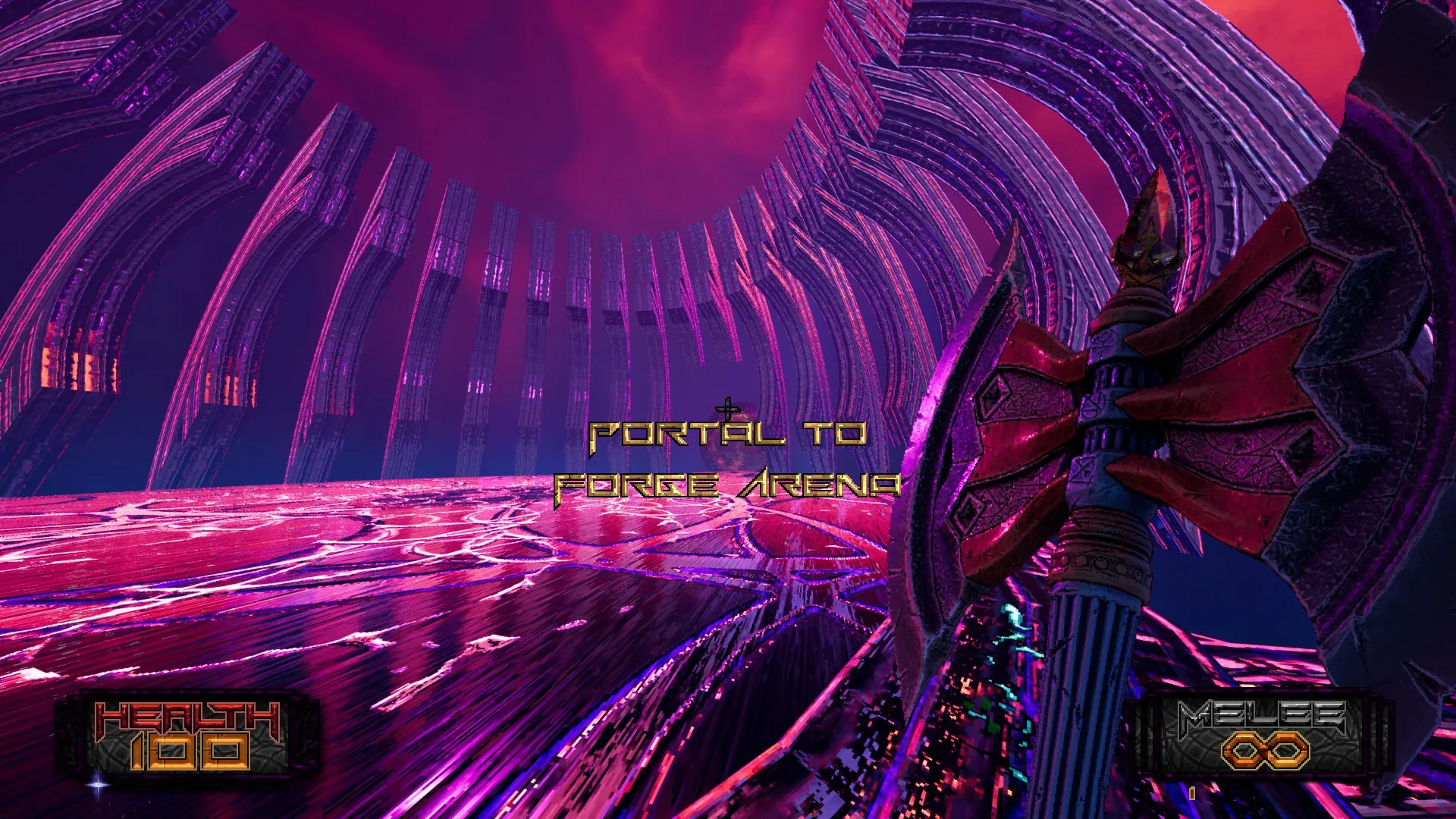
The player starts in a hub which connects all of the worlds through portals ala Quake. Each of the seven levels features four episodes, the last of which is a boss fight. Even the Horde Mode has its own hub that leads to 4 unique maps to give it extra replayability. Horde Mode is a challenge for those who finish the game and really want to test their skills against endless waves of enemy NPCs. It’s fun but frustrating.
Another reason a player may want to play it over is to find all of the hidden secrets, and they are not easy to find on the first playthrough. Plus there are multiple levels of difficulty up to EVIL, with Easy still being challenging, and Normal acceptable for most experienced FPS players.
The audio and the music are outstanding. The music composer is the famous Andrew Hulshult, and he scores AMID EVIL perfectly. The music always fits the mood or the action and it is hypnotic. The music tempo rises as the fighting heats up adding to a player’s excitement. Weapons sounds are very good to match the impacts on the screen. The audio also gives good positioning clues and a player should always listen before entering a new area.
There are brief respites between fighting to admire the scenery, look for hidden objects, or to solve the puzzles. The puzzles are not very challenging, but finding switches are sometimes difficult as they are often really well hidden. Overall, AMID EVIL wisely focuses on the intensity of the action parts of the game. There is also a lot of platforming with many jumps to narrow ledges. If you miss, there is generally no fall damage, but you will lose time to recover lost ground as there are no checkpoints and only rare auto-saves, and you may have to use quicksave.
Boss battles are sometimes very challenging, but it often depends on if your soul meter is charged fully when you enter the arena or not. If your soul meter is fully charged, you can unleash on the boss and often it will be a disappointingly easy battle if you have enough mana to use the Celestial Claw and the Aeturnum while supercharged. If not, you will have your work cut out for you.
We experienced some very minor issues with bugs but nothing that stopped our progress. The game is well-polished. AMID EVIL only offers the choices to launch with DX11 unless the 2GB beta RTX branch of the game is downloaded. You can download the RTX beta branch and play the ‘Lost Falls’ level with RTX shadows and reflections enabled but you need to realize that it is an unoptimized beta version. The devs are still working to optimize ray tracing and to add DLSS 2.0 to improve performance.
DX11 looks great although it doesn’t offer ray tracing options so we will concentrate on DX11 and also on DX12 RTX performance separately.
Performance Options
Before a player starts to seriously play AMID EVIL, it’s good to know where the save game, screenshots, and the configuration files are located.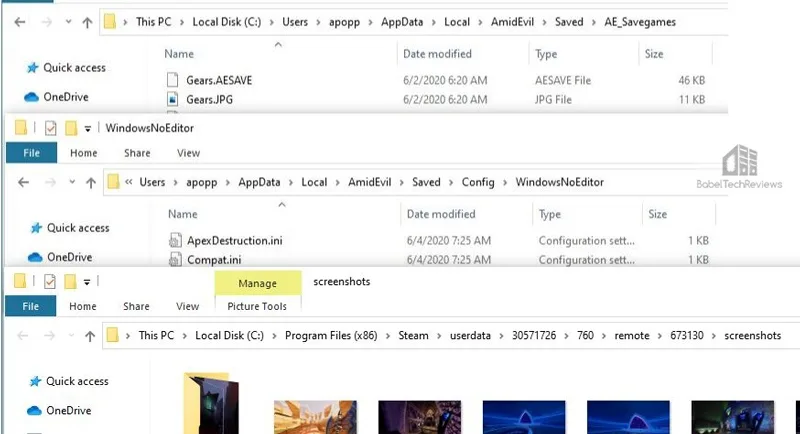
Here are the graphics settings that we used and changed for benchmarking – Resolution (3840×2160/2560×1600/1920×1080), ray tracing options both checked when available, Overall Epic quality, Anti-Aliasing (Temporal/TAA), and 100% resolution scaling. As the RTX branch is still beta, there was no 2560×1440 resolution available to us, and Fullscreen mode doesn’t work properly unless your chosen game resolution matches the desktop resolution.
Since DX12/RTX features are beta, we found a few issues with setting the resolution so we had to change them in options and we also had to edit the configuration files. For benchmarking, settings are set to their highest Epic level at a rendering resolution of 100%.
To use the beta branch to play with RTX features, go to the AMID EVIL Steam game properties and enter the password AmidRTX12345. After downloading it, go to Ray Tracing options in the main options menu and check both shadows and reflections for the ‘Lost Falls’ episode, but do not check shadows when you play the rest of the levels; they have not been implemented yet and may cause some visual artifacts.
DX11 versus DX12 performance & Anti-Aliasing
Anti-Aliasing
The only available choices for antialiasing are either FXAA or TAA – or you can leave it off.
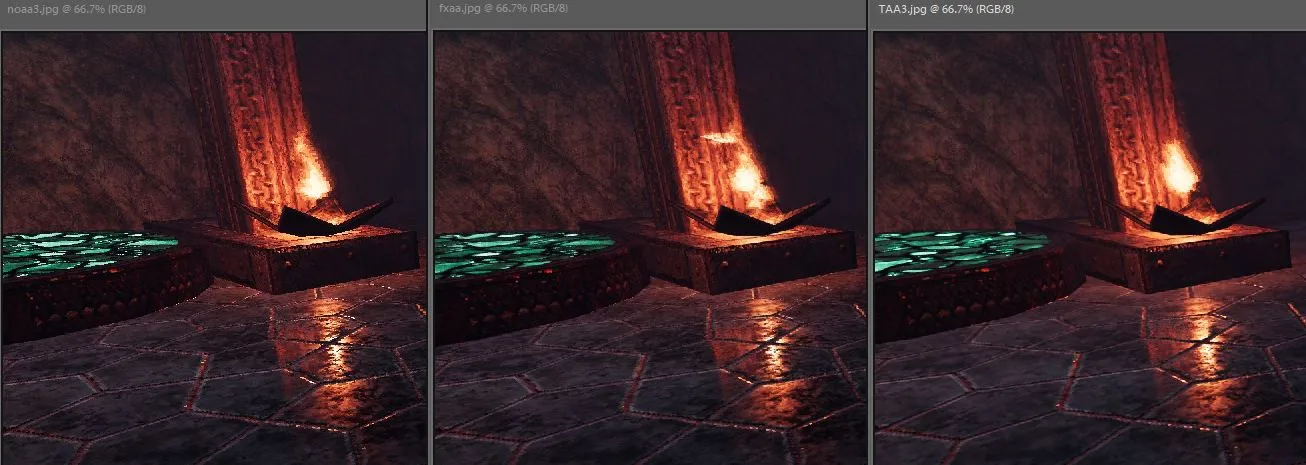
No AA works for screenshots since the game is deliberately pixelated anyway, however, with the camera in motion, the crawling and shimmering is very distracting. FXAA gets rid of some of the jaggies in stills but it doesn’t work well when in motion. Fortunately, TAA gets rid of most of the jagged edges and reduces crawling and shimmering while only taking a small performance hit with a little acceptable blur.
For the above chart’s AA performance results, we use a RTX 2060 Super Founders Edition at stock clocks. Playing AMID EVIL on the DX11 pathway will give better performance than with the DX12 API, but the performance difference is so small between No AA, FXAA, and TAA that there is no reason not to use TAA. However, the performance hit with RTX On is absolutely massive. The game is begging for DLSS 2.0 and it is great news that the devs are working with NVIDIA to implement it.
Ray Traced Reflections & Shadows
Instead of prebaked rasterized lighting that game developers have had to use, ray tracing gives superior lighting and shadowing which works well with the effects that AMID EVIL strives for. These ray traced reflections are used consistently all through the beta branch of the game, but ray traced shadows are only used for the ‘Lost Falls’ episode. We suspect that NVIDIA provided assistance through their Indie Spotlight Game Developer Program to help the AMID EVIL devs create realistic lighting and shadowing effects that cannot be achieved using rasterized techniques alone.
AMID EVIL’s incredibly varied environments are a good showcase for ray tracing which feature realistic shadowing and cast realistic reflections on reflective surfaces, increasing image quality, and enhancing immersion. With ray tracing, the RTX ray-traced reflections and shadows are based on the exact geometric detail and dynamic lighting of a scene for better image quality.
RTX Off vs. RTX On Epic/TAA settings
At Epic settings and with TAA (no DLSS yet) at 100% native resolution at 1920×1080, we compare ray tracing RTX Off (Slider to Left) versus RTX On (Slider to Right).
[twenty20 img1=”17525″ img2=”17523″ offset=”0.5″ before=”RTX ON” after=”RTX OFF”]
It’s obvious that ray tracing adds more to the visuals of the scene just by turning it on. The scene with RTX On is more natural and the reflections are calculated in realtime, unlike with the prebaked RTX off scene. However, both scenes use TAA which add blur to each image. Now we want to look at shadows.
[twenty20 img1=”17524″ img2=”17522″ offset=”0.5″ before=”RTX ON” after=”RTX OFF”]
In this case, the RTX Off (Slider to Left) scene has hard shadows whereas the RTX On (Slider to Right) scene accurately calculates the shadows in realtime and the overall lighting effect is more natural even though it is in a fantasy setting. But AMID EVIL’s beta ray-tracing takes a huge performance hit.
RTX Performance
To fluidly play with ray tracing and shadows on, one needs an absolute minimum above 60 FPS, and higher is better. So the only two cards that can play Epic/TAA AMID EVIL at 1920×1080 are the RTX 2080 Super and the Ti, with the Ti providing a superb experience.
However, players can certainly forget about playing in 4K and NVIDIA’s fastest consumer video card, the RTX 2080 Ti, struggles with mid-30s FPS averages. At Epic/TAA settings, AMID EVIL runs fluidly at 1920×1080 and perhaps acceptably at 2560×1440 using a Ti. This game is crying out for DLSS 2.0 and optimization, and when it is patched in we shall revisit performance and IQ again.
To play at Epic 4K settings and with ray tracing on will require the use of AI super resolution or DLSS 2.0 (Deep Learning SuperSampling) which provides IQ similar to or better than FXAA or TAA but with better performance. Ray tracing provides the next generation of visuals, and coupled with DLSS, it boosts performance to be able to play at fluid frame rates.
We played most of the game in DX11 on a RTX 2060 Super with Epic/TAA 1080P settings and we enjoyed it thoroughly. However, after playing the fully ray traced Lost Falls level and then revisiting the rest of the game with a RTX 2080 Ti, we came to love the RTX effects. There is no other way to put it – ray tracing adds to a game’s visuals – and in the case of AMID EVIL, it adds quite a lot.
Conclusion
AMID EVIL is an excellent retro FPS action game and it has brought a lot of fun to the 30 plus hours we played and replayed it. We are impressed by AMID EVIL’s gameplay and visuals, and we are looking forward to DLSS 2.0 so we can appreciate it with ray traced lighting and shadows at higher resolutions. For now, the RTX 2080 Super/Ti are mostly required to play the game smoothly at 1080P. Of course, the entire RTX implementation is still a raw beta, but it looks awesome and if you have a capable card, check it out. After DLSS 2.0 is patched in, we will follow up with a final performance/IQ evaluation, and hopefully, with an interview with the developer.
Although we appreciate the retro look, we would still like to see further upgraded visuals with perhaps an optional texture pack. AMID EVIL is incredibly polished on the DX11 pathway and runs on a PC ‘toaster’. Of course, with upgraded visuals, RTX would run more slowly; but then NVIDIA next generation of faster RTX video cards are undoubtedly coming this year.
AMID EVIL is great fun right from its opening, and it pulls you into its strange fantasy world delivering epic first person battles with such impact and intensity that define high action gaming immersion. If you are a completionist looking to find every hidden item, achievement, and secret, you may put 30 or more hours into the game as we did. If you just play it using a walkthrough, you may be done within ten or so hours but you will miss most of the fun of exploration.
AMID EVIL deserves a “8.7/10” in our opinion as a great retro style action game that does what it does very well. It is hard to believe that a small indie studio was able to pull off such an incredible effort, and we look forward to their expansions, sequels, and future games. The visuals are absolutely outstanding, and the ray tracing effects add to its immersion and stunning ultramodern retro look and feel. It almost like reliving the excitement of the 1990s FPS scene again – but everything has been upgraded, reimagined, reworked, and improved. We can’t wait for DLSS 2.0!
Next up, we are going to review a Team Group CARDEA Z340 SSD. It’s important for a gamer to get right back into the action instead of waiting around for a hard drive to reload.
Happy Gaming!

